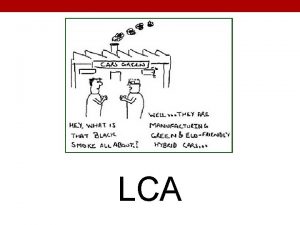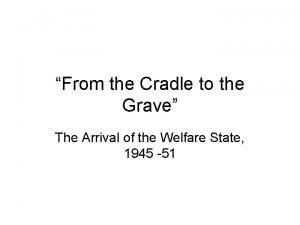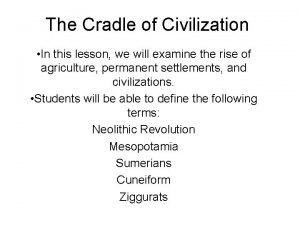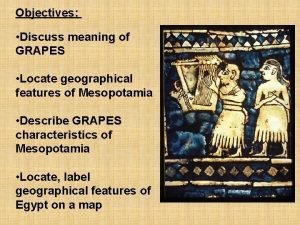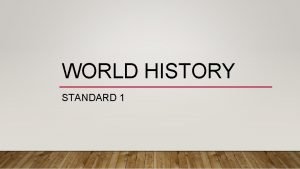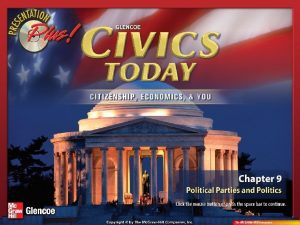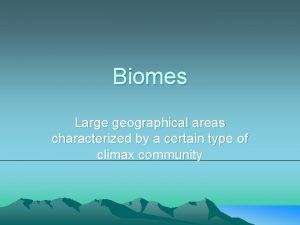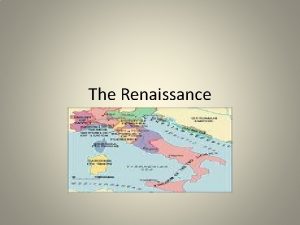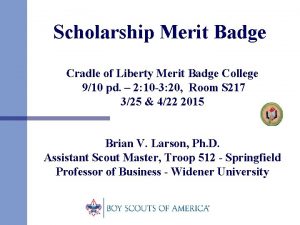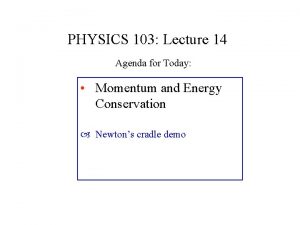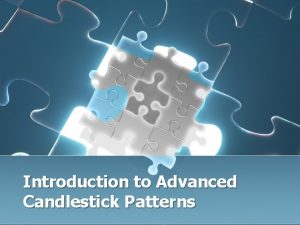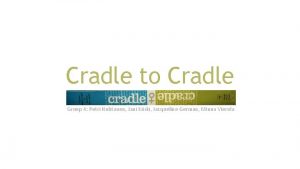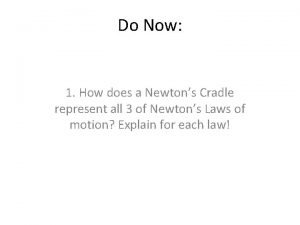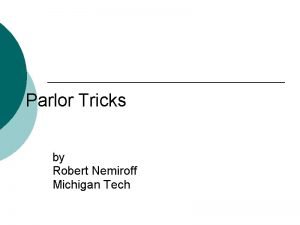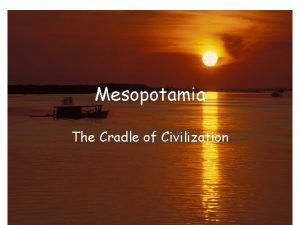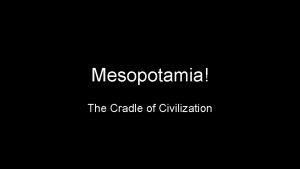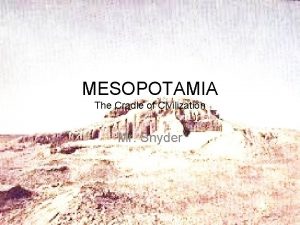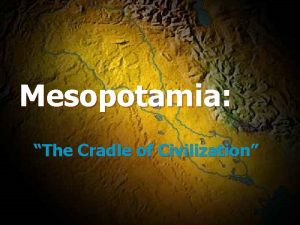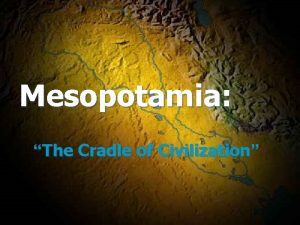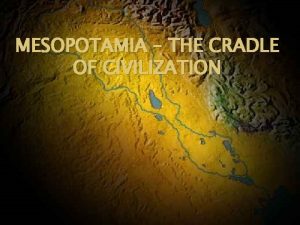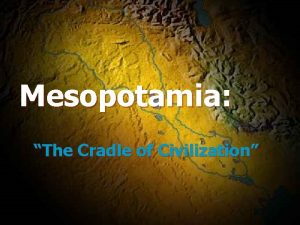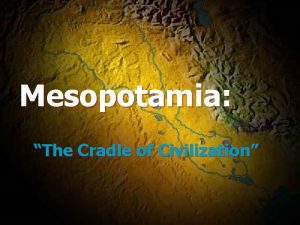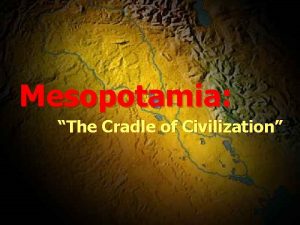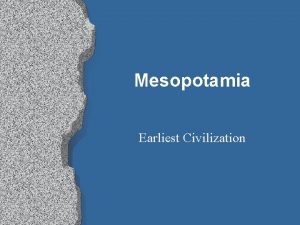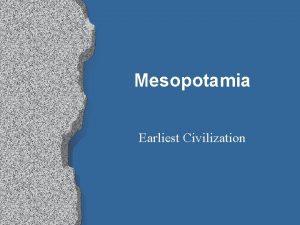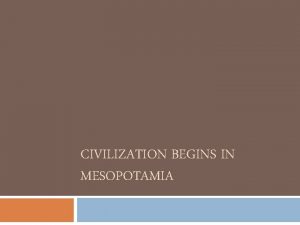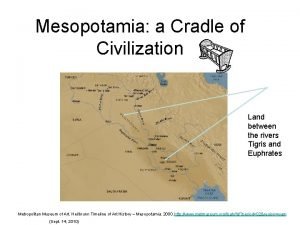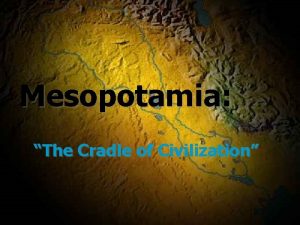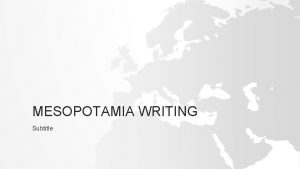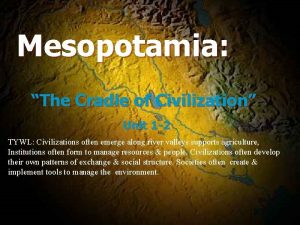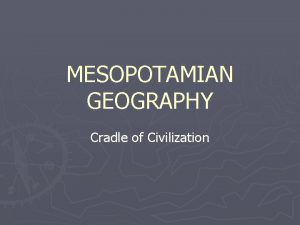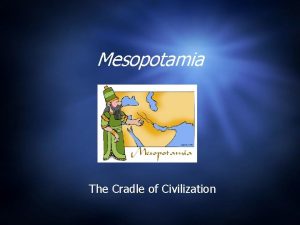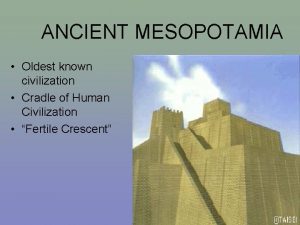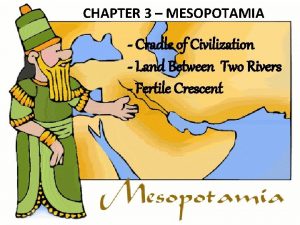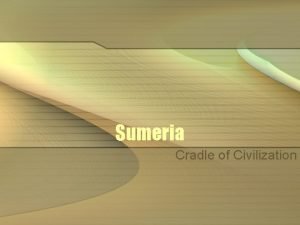Mesopotamia Cradle of Civilization Mesopotamia Geographic area In



























- Slides: 27

Mesopotamia Cradle of Civilization

Mesopotamia Geographic area. In modern day country of Iraq The name means “land between 2 rivers” 2 Rivers- Tigris River and Euphrates River

Mesopotamia The constant water supply from the 2 rivers provided rich farm land ideal for growing crops. p The rivers flooded each spring, the early people in the area built levees to keep the flood waters back and built irrigation systems. p

Mesopotamia Area was first settled about 4500 -4000 B. C. p These people were originally farmers, herders, and fishermen. p They made tools, bricks, clay figures, and pottery. p

Sumer p p p The people who lived there were called Sumerians The first known civilization around 3500 B. C. The Sumerian people made wagon wheels, used copper and bronze, made sail boats, used plows, wrote laws, and studied astronomy.

Sumer Important city states developed p Built strong walled cities for protection from outside invaders p Important Sumerian city. Ur (capital of Sumer) had a population of around 200, 000 Most cities were unattractive- no public services available to remove garbage and sewage. This was left to pile up on the streets. p

Sumerian Cities p p p Streets were narrow, unpaved, winding Houses were one story mud brick structures with flat roofs. Members of the upper class had 2 story houses with many rooms that included sleeping quarters and servants quarters and burial plots below the house Household utensils made out of stone, copper and bronze Merchants supplied the townspeople with material items

Religion p p p Sumerians constructed shrines or temples called Ziggurats were to serve as a pedestal for the gods to descend to Earth. On top was a shrine room where people would pray or hope to entertain a divine visitor.

Religion Public was not invited to engage in temple rituals, but they needed to constantly pray or the gods would not bless their lands. p Around the ziggurat were courts where artisans worked, children went to school, and people traded and stored goods there. p Sumerians believed that all of nature was controlled by gods p

Education p p p The Sumerian schools were called “tablet houses” and were used to educate scribes for various religious, governmental, and commercial jobs. Schools at first were mostly religious and were for rich children Male only Classes went from morning until sunset Curriculum included- grammar, penmanship, science, and math

Writing helped man maintain a complex economic and political society p Sumerian writing dates back as early as 3100 B. C. p Dried Mud tablets with a sharp pointed reed called a stylus was how they wrote the cuneiform. p This writing was adopted by their conquerors and used for about 2000 years. p

Family Life Woman had rights in Sumerian society p They could buy and sell property and could run businesses p The husband was the head of the household p He could divorce his wife or rent out his wife and children for up to three years p Children were expected to support their parents when they became old p

Priests and Kings p p p Priests were also the kings of the city-states Gilgamesh was the most famous Received advice from an assembly of free men During wars, the assembly chose a military leader to serve until the war was over Eventually, these leaders stayed in charge and became kings. Kingship became hereditary

Ticket out the Door

Section 2 Later Mesopotamian Empires

Sargon 1 Ruled an area called Akkad p Began to conquer city-states one by one and became king of all of them p Created world’s first empire p Ruled for 50 years p

Hammurabi of Babylon Hammurabi was king of Babylon who conquered Akkad and Sumer p The Babylonians took on the language and religion of the people they conquered p Hammurabi improved irrigation systems and changed the religion p Developed his own set of laws called the Code of Hammurabi p

Hammurabi Appointed judges to carry out the code p Judges were punished if not honest p He believed people were innocent until proven guilty p During Hammurabi’s rule, Babylon became a trade center p Hammurabi’s reign is known as the Golden Age of Babylon p

Ticket Out the Door p How is Hammurabi’s code similar to the laws in the United States?

Section 3 Contributions

Inventions and Contributions p Inventions and customs of the Sumerians and Babylonians were copied and improved upon by other cultures.

Inventions and Contributions Oldest written records in the world p First written laws p Cuneiform was a model for other people’s system of writing p

Inventions and Contributions Invented the wheel which aided transportation p Invented the plow which allowed farmers to grow more food p Invented the sailboat which replaced muscle power with wind power p

p wheel

Inventions and contributions Developed a 12 month calendar based on the cycles of the moon p It marked the times for religious festivals and planting p

Inventions and Contributions to math p Developed a number system based on 60 p 60 minute hour p 60 second minute p 360 degree circle p Clock that was controlled by water p

Ticket out the Door
 Mesopotamia the cradle of civilization worksheet answers
Mesopotamia the cradle of civilization worksheet answers Cradle to grave cradle to gate
Cradle to grave cradle to gate Cradle to cradle boek
Cradle to cradle boek Cradle to grave housing report
Cradle to grave housing report Cradle to cradle design
Cradle to cradle design The cradle of civilization
The cradle of civilization Nile river clipart
Nile river clipart Conclusion
Conclusion A geographic area that contains a specific number of voters
A geographic area that contains a specific number of voters A large geographic area characterized
A large geographic area characterized Leg cradle to lateral lunge
Leg cradle to lateral lunge Lakeshore reveries
Lakeshore reveries Okonkwo's violent acts and consequences
Okonkwo's violent acts and consequences Compact city
Compact city Cradle of the renaissance
Cradle of the renaissance Golden cradle kindergarten
Golden cradle kindergarten Cradle alignment techniques
Cradle alignment techniques Dynamics of machines
Dynamics of machines Scholarship merit badge requirements
Scholarship merit badge requirements Cradle to grave
Cradle to grave Newton's cradle
Newton's cradle Cradle candlestick pattern
Cradle candlestick pattern Limburg principles
Limburg principles Newton's cradle
Newton's cradle Cradle of liberty merit badge college
Cradle of liberty merit badge college Newton's cradle tricks
Newton's cradle tricks Conclusion of comfort device
Conclusion of comfort device Beef skinning cradle
Beef skinning cradle

